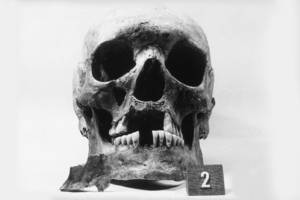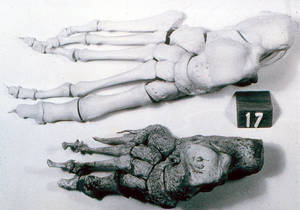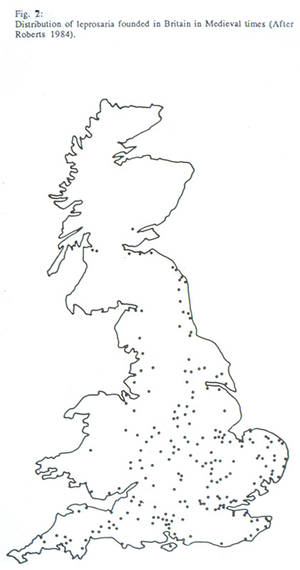Leprosy in the Past - the Story in the Bones
Interview with
Diana - Now, to help us understand leprosy, it's important to look into the past and see what evidence we can find from when and where it's prevalent. One way to do this is to look for the marks it leaves on the bones. Joining us now is Professor Charlotte Roberts, a bioarchaeologist from Durham University; she studies evidence for disease in skeletons that are excavated from archaeological sites... Hello.
Charlotte - Hello.
Diana - So what is the evidence of leprosy in bones? How do we spot it?
 Charlotte - Well, it primarily affects the bones of the face, the nasal area where the bacteria, as Diana [Lockwood] has just said, is inhaled and you get destruction of those areas of the face. It also affects the nerves, again as Diana has said, where you get loss of sensation, and loss of proper function of the muscles or the nerves supplying the muscles. And so, all these manifestations of leprosy can affect the bones, so we get the loss of bone from the upper jaw, loss of front teeth, perforated palette bones in the skull, and then because of development of ulcers on the hands and the feet due to lack of sensation in those areas, you'll get involvement to the bones of the hands and the feet, and you'll get loss of parts of those bones.
Charlotte - Well, it primarily affects the bones of the face, the nasal area where the bacteria, as Diana [Lockwood] has just said, is inhaled and you get destruction of those areas of the face. It also affects the nerves, again as Diana has said, where you get loss of sensation, and loss of proper function of the muscles or the nerves supplying the muscles. And so, all these manifestations of leprosy can affect the bones, so we get the loss of bone from the upper jaw, loss of front teeth, perforated palette bones in the skull, and then because of development of ulcers on the hands and the feet due to lack of sensation in those areas, you'll get involvement to the bones of the hands and the feet, and you'll get loss of parts of those bones.
Diana - Okay, so it sounds like it's mostly skull, hands, and feet.
Charlotte - That's right, yes.
Diana - But do you see any other diseases which affects bone in a similar way that could be confused with leprosy?
Charlotte - Yes. In the skull, you may get people with tuberculosis or indeed, syphilis where you'll get similar changes, but what we're always trying to do when we're looking at skeletons, is to look at the distribution pattern of the lesions that we see in the bones, which helps us make specific diagnoses. And so, if you got a complete skeleton, I'll have to admit it's not often in archaeological sites where the whole skeleton is preserved, you can look at the distribution pattern and you can be pretty safe when you have someone who's been suffering from leprosy.
Diana - So the more of the body you've got, the better.
Charlotte - That's right.
 Diana - So, can we confirm a diagnosis just from the bones or can you use other techniques? Has DNA been used on them?
Diana - So, can we confirm a diagnosis just from the bones or can you use other techniques? Has DNA been used on them?
Charlotte - Yes. Since 1994 actually, people have started to extract the DNA of the bacteria that causes leprosy from bones of the skeleton quite successfully. In many cases, this has confirmed a diagnosis where we have seen the bony changes that we would recognise as leprosy and then the DNA has confirmed that diagnosis. People have also taken histological sections from bones and found particular patterning in those histological sections that are recognisable as leprosy. So, yes, there are other methods that we can use, but most people don't have access to that methodology and tend to just look at the visual signs of leprosy in the skeleton.
Diana - Yeah, I suppose that the beauty of looking at the bones is that you can almost identify it in the field on site.
Charlotte - Yeah. I mean the other thing to say is of course, depending on how resistant you are to the bacteria, you'll develop a different patterning of bony changes in the skeleton. So if you're very resistant to the bacteria, depending on your immune system strength, then you may not develop the very obvious signs, but if you're not very resistant to the bacteria, it'll be very obvious in the skeleton.
Diana - Okay, so when do you get the first evidence of leprosy? What's the oldest skeleton that's been found?
Charlotte - Well, there've been suggestions that we've got evidence from about 2500 BC in Turkey and in Nubia, and in India about 2000 BC. There is a suggestion that a child skeleton from a Scottish site dated to 2000 BC, but that hasn't been confirmed yet.
Diana - So it's pretty ancient then?
Charlotte - It is pretty ancient, but it doesn't really increase in frequency until about the 12th to 16th century in Europe, and then it really seems to increase in frequency, along with the introduction of leprosy hospitals which were founded around that time.
 Diana - Of course, in the leprosy hospitals, I think most people will have heard about. So, can you tell us a bit about hospitals? How many were there, just in Britain for example?
Diana - Of course, in the leprosy hospitals, I think most people will have heard about. So, can you tell us a bit about hospitals? How many were there, just in Britain for example?
Charlotte - Just in Britain, probably over 300 in England alone and mainly founded in the south and east, and this was between the 11th and 16th centuries. They tended to be founded by wealthy benefactors who were really concerned about their own salvation, and they really controlled admissions. Whether you got admitted, if you were diagnosed with leprosy, depended on how rich you were and maybe your religious affiliation, and maybe sex. You know, maybe the males got admitted more than the females.
Diana - Most people say that these leprosy hospitals were sort of built outside cities and that people with leprosy were kind of sidelined or marginalised from mainstream society. So, do you think this is true?
Charlotte - I don't think so, no because recent evidence that I've looked at suggests that the majority of individuals with the bony changes of leprosy were not actually buried in leprosy hospital cemeteries. They were buried in the normal community cemetery and that, I think, suggests that perhaps, our assumption that everyone was stigmatised in the past doesn't hold true, and that communities actually accepted these people.
Diana - I wonder where this idea comes from then...
Charlotte - Well I think it's a view that was actually forwarded in the 19th century and that was based on their medieval evidence. I think the historical data that's been looked at by people like Carol Rawcliffe at the University of East Anglia, and myself looking at the skeletal evidence for leprosy, has really turning those assumptions we have about how people were treated with the leprosy and the past over.
Diana - Well, as my director of studies used to say, "History is the handmaiden of archaeology."
Charlotte - Certainly.
Diana - That was Professor Charlotte Roberts and she's from Durham University. Thank you.









Comments
Add a comment